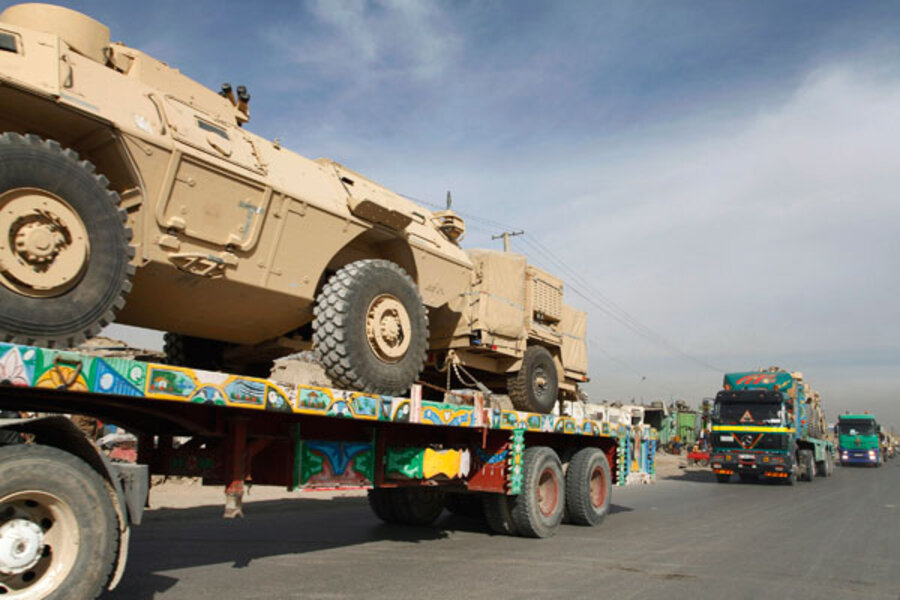How 'deluge' of US military spending fed corruption in Afghanistan
Loading...
| WASHINGTON
The US government has inadvertently empowered warlords and nurtured corruption in Afghanistan, warns a strikingly candid new report from the Pentagon that offers a devastating window into worthy US intentions that ended in exorbitant waste.
The initial US focus on defeating the Taliban and Al Qaeda created mutually dependent relationships between the US government and Afghan warlords “that empowered these warlords” and “expanded their opportunities for financial gain,” according to the study, which was produced by the chairman of the Joint Chiefs of Staff’s “lessons learned” department.
This was caused in large part by a “deluge” of military spending that “overwhelmed” the Afghan government’s ability to absorb it and later encouraged spending habits and graft that impeded the US war effort, the report concludes.
The study, commissioned by Gen. Joseph Dunford, the commander of US forces in Afghanistan, offers an interesting military history lesson from experienced military planners. The authors note, for example, that early in the war, the country’s geography “provided significant challenges during the development of military plans in the aftermath of the 9/11 attacks.”
The US military allied with an existing proxy force – in the form of the Northern Alliance – to defeat the Taliban, which met the Pentagon’s goal of driving out the government giving shelter to Al Qaeda (AQ) leader Osama bin Laden.
“But it also served to strengthen some of the warlords within Afghanistan,” the report notes. “With US support and patronage (which continued after the Taliban and AQ were driven from Afghanistan), these warlords were able to operate with impunity and improve their political positions.”
In order to bring these warlords under the umbrella of the new government, Afghan president Hamid Karzai gave them key cabinet positions “as a way to obtain loyalty.” The 25 ministries within the government of Afghanistan (Government of the Islamic Republic of Afghanistan, or GIROA, in the report) gave Mr. Karzai ample opportunities to do this.
“Once ensconced within ministries and other government posts, the warlords-cum-ministers often used their positions to divert GIROA resources to their constituencies,” the report adds. “The new ministers saw the scramble for power and resources as a means to enhance their standing, and diverted resources accordingly.”
Even as it became increasingly clear that the warlords were embezzling millions in US taxpayer funds and creating “criminal patronage networks” with the cash, Karzai, politically dependent on the warlords, resisted the pressure of US military officials to replace them. “As one senior civilian advisor noted, ‘[prosecution] meant Karzai would be putting one of his allies in jail.' ”
The US military fed into the corruption as well, not only through a “deluge” of poorly managed cash but also in their need for transportation networks. As the report notes, “Afghanistan’s geography and infrastructure were not conducive to supporting a large military occupation force, particularly one that traveled as heavily as the US military.”
Fewer than 15 miles of railway existed in Afghanistan at the start of the war, for example, and the nearest seaport was in Karachi, Pakistan. US forces came to war without “sufficient long-haul transport” to support its supply chain, which led to its decision to employ contract truckers, who in turn hired private security guards to protect their convoys. “As one senior officer noted, ‘If we occupy a country, we need large-scale contracting. There is no way around it,’ ” the report explains. “However, many of the private security companies hired by the trucking companies were of a dubious nature.”
The report cites the work of the Special Inspector General for Afghanistan Reconstruction, which released its quarterly report Wednesday, noting that Afghanistan’s institutions lacked the ability to handle the large sums of money” that they received in aid. This, “coupled with weak oversight by ISAF [International Security Assistance Force] and the international community, created ample opportunities for corruption” as well as “capital flight, usually illicit.”
This has been driven in large part by the fact that US military had an accounting oversight system that one US general described as “more suitable to Peoria than Kabul,” according to the report. What’s more, US military officers were rated more highly by their commanders for distributing money into communities, which was seen as winning hearts and minds.
Although corruption has long been cited as a considerable obstacle by US military officials, it threatens to become even worse, since the looming 2014 deadline for withdrawing US combat troops from Afghanistan has created a new and fierce “scramble for power, influence, and resources in order to survive.”
As a result, the report notes, “a lot of Afghans, especially the bigwigs” have started moving whatever resources they can grab out of the country and into secret overseas accounts, moves that have left everyday citizens feeling angry and disenchanted. In a recent survey of Afghans, 80 percent described corruption as a “major problem” throughout the country, and two thirds believe it is getting worse.





